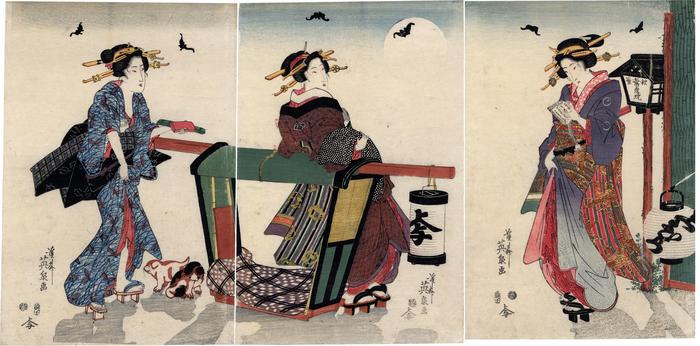Keisai Eisen (渓斎英泉) (artist 1790 – 1848)
The Night Lamp at Akiba (秋葉常夜燈)
ca 1821
30 in x 15 in (Overall dimensions) Japanese color woodblock print
Signed: Keisai Eisen ga
渓斉英泉画
Publisher: Uemura Yohei
(Marks 564 - seal 05-007)
Censor's seal: kiwame
Seal: Futakata (on rt. & lft. panels only)
Carver: Hori Takichi
National Museums of Scotland
Tokyo Metropolitan Library - right panel only with artist's 'Kei' (渓) seal
Náprstek Museum - right-hand panel only
Philadelphia Museum of Art - right-hand panel only
Nationaal Museum van Wereldculturen (Rijksmuseum Volkenkunde, Leiden) via Ritsumeikan University - left-hand panel only
Nationaal Museum van Wereldculturen (Rijksmuseum Volkenkunde, Leiden) via Ritsumeikan University - right-hand panel only
Chiba City Museum of Art Bats flit in the sky, a lantern stands at the right with the inscription "Akiba All-night Lantern," the moonlight casts shadows on the ground where two puppies play. . . Apart from these skillful evocations of atmosphere, there is little to distract the eye from the three figures: a geisha on the right, who comes humming to herself with a songbook in her hand, the woman who waits for her leaning against the palanquin, and the young attendant who stands behind. This work from the Bunsei era is one of the most successful of Eisen's triptych's.
****
The publisher's seal appears not only on each individual panel, but also on the lantern hanging from the pole of the kago or palanquin resting on the ground.
There is a curious difference between the right-hand panel in the Lyon Collection and that of the one in the Tokyo Metropolitan Library. Not only does the one in Tokyo have the 'Sen' (泉) artist's seal, but it also has three black bats flying through the air. The Lyon Collection example only shows two and no artist's seal. This would probably indicate two different editions. The full example in Scotland not only has more bats, but their right-hand panel has the same number as the example in Tokyo and also shows the artist's seal.
The example of this triptych in the Chiba City Museum is similar to the one here, but the treatment of the darkened sky at the top is different. Perhaps a third edition. This would make sense considering the beauty of this composition. It must have sold out more than once and called for more printings. (JSV)
****
The Chiba City Museum of Art's curatorial notes refer to this composition as one of the masterpieces of the early Bunsei period (1818-30). We wholeheartedly agree.
There are so many qualities to this triptych, but one particularly spectacular element is the shadows cast both by the moon and the lantern. This effect is not to be seen very often in other ukiyo-e prints. It is one of those subtleties which sets this apart from so many other such examples. (JSV)
****
Illustrated:
1) in color in 浮世絵師溪斎英泉, 千葉市美術館 (Keisai Eisen: Artist of the Floating World, Chiba City Museum, 2012, #23, p. 54.
2) in color in 原色浮世絵大百科事典 (Genshoku Ukiyoe Daihyakka Jiten), vol. 5, p. 61, #218.
3) in color in Ukiyo-e Masterpieces in the Collection of Chiba City Museum of Art (千葉市 美術館 所蔵 浮世絵 作品選 - Chiba-shi Bijutsukan shozō ukiyoe sakuhinsen), 2001, p. 64, #139.
4) in color in Catalogue of Japanese Art in the Náprstek Museum published by The International Research Center for Japanese Studies: Nichibunken Japanese Studies Series 4, 1994, p. 126. The right panel only.
****
Other copies of the right and left-hand prints can be found in the Rijksmuseum voor Volkenkunde, Leiden.
Uemura Yohei (上村与兵衛) (publisher)
beautiful woman picture (bijin-ga - 美人画) (genre)
bats (komori - 蝙蝠) (genre)
